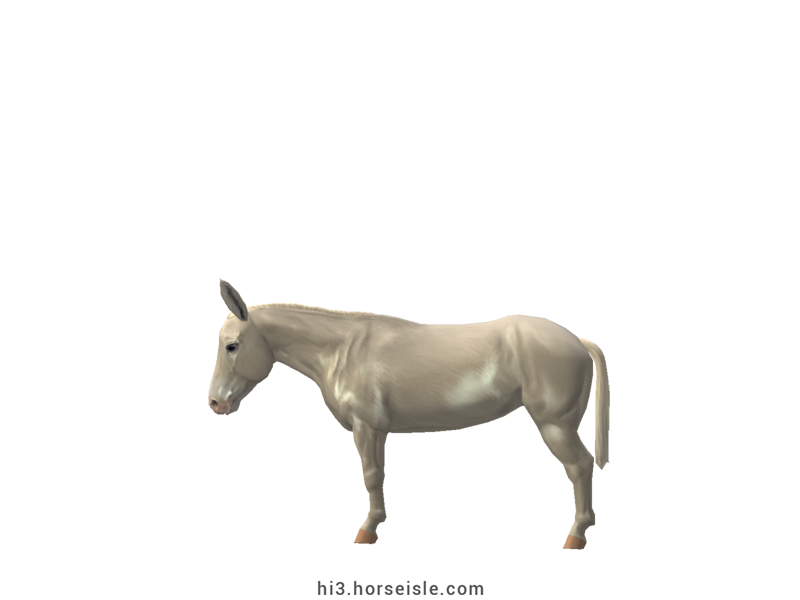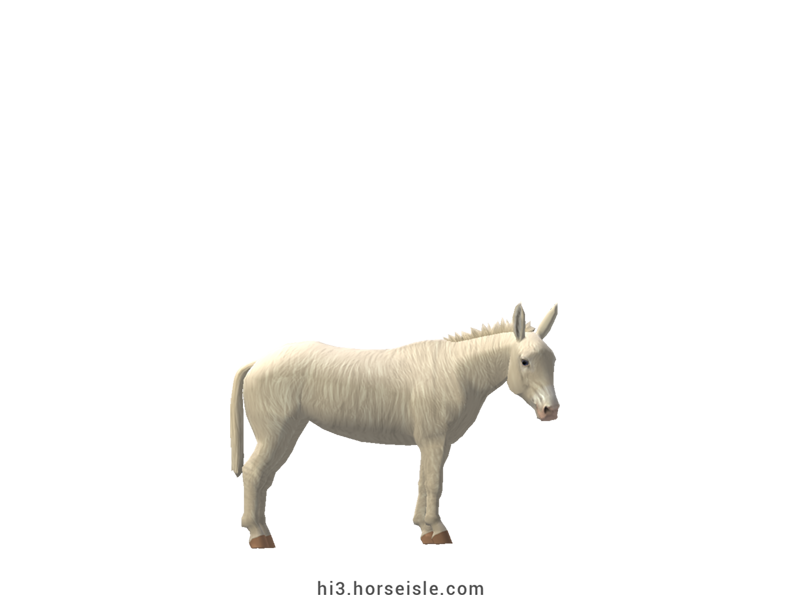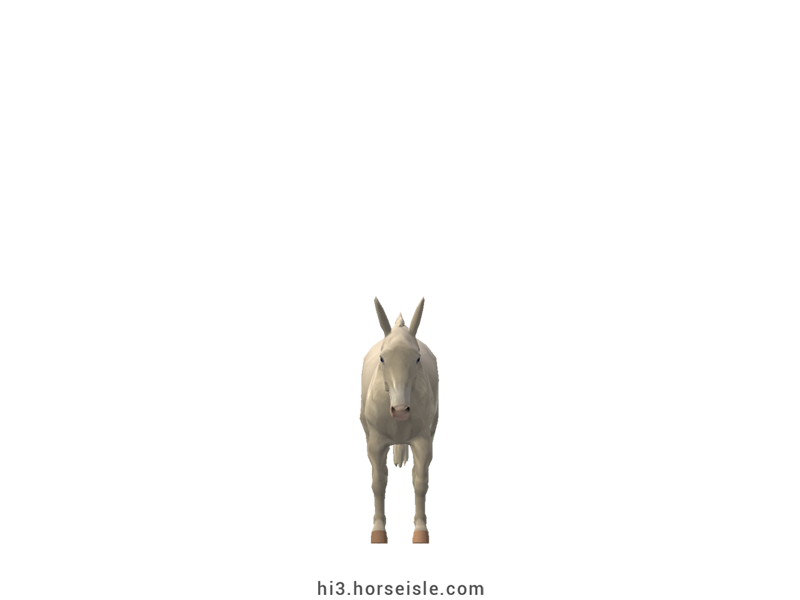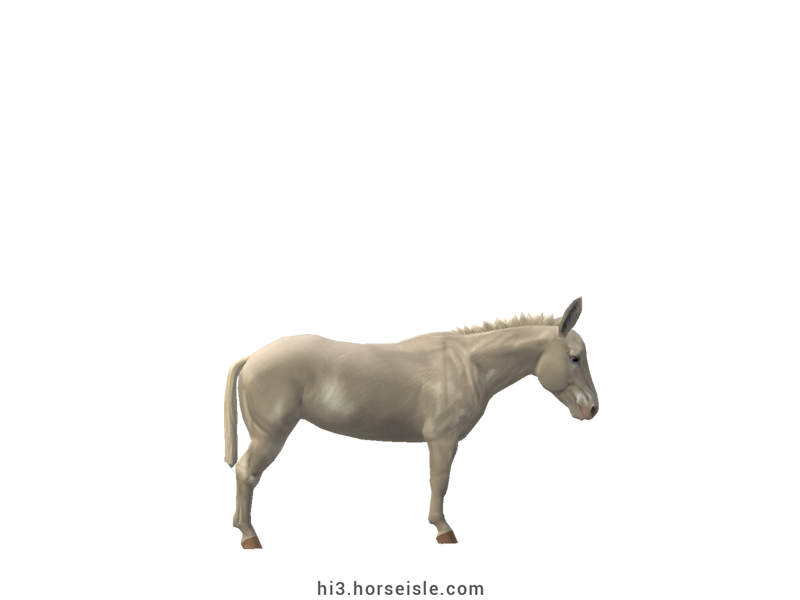Our Massive Real World Equine Reference!
[ INDEX ] Equine Type: Donkey Breed: Austro-Hungarian Albino Donkey (A-H Albino) [ PREV ] [ NEXT ]
The Austro-Hungarian Albino Donkey ('A-H Albino' in Horse Isle for short; also known as 'Austro-Hungarian White Baroque Donkey') is a breed of an ivory colored donkey (not albino nor white).
A highly fashionable donkey:
Although the A-H Albino might look like no more than a medium-sized, white-colored donkey, it was originally quite a celebrity in the region which would later become Austro-Hungary. It was during the 17th and 18th centuries, when the Baroque and Rococo styles were popular, and white was the preferable color from clothes to pets.
The A-H Albino's small size and white coat made it a highly-fashionable pet among the upper class. It remained popular among the high society in Austria and Hungary even after the Rococo era ended, but it eventually fell out of fashion in the 19th century.
Falling out of fashion but not out of mind:
Due to its small size (10.1hh to 12.1hh), the A-H Albino never had any usages other than serving as a pet. Therefore, after it fell out of fashion, the practice of its breeding declined, and the breed became rare.
Although it is commonly stated that the A-H Albino was forgotten during the 20th century, it was actually still bred in small numbers in a few locations in Austria and Hungary. One of those locations was Herberstein Zoo in Austria, where, starting from 1960, visitors could see and enjoy the rare, white donkeys.
Preserving the Austro-Hungarian Albino Donkey:
In 1986, Prof. Fritz Dietrich Altmann, an Austrian veterinarian and zoologist, visited the Herberstein Zoo and realized that their white donkeys might be the descendants of the original A-H Albinos that roamed Austria a century ago.
Almost a decade later, another herd of white donkeys was discovered by Kurt Kirchberger at the Lake Neusiedl National Park which spans over the border between Austria and Hungary. Although the donkeys roamed on the Hungarian side, it was clear that they are A-H Albinos like the ones found in the zoo.
Those two herds were soon crossed together, as well as with A-H Albinos that were bought from private breeders, to stabilize the population of the A-H Albino and preserve that unique breed.
The Austro-Hungarian Albino Donkey today:
Today, A-H Albinos are primarily bred in two locations in Austria. The first is Lake Neusiedl National Park, where the donkeys roam freely in the sandy habitat of the park and feed on the local plants. This helps maintaining a healthy balance between the various plant and animal species.
The second location is Schloss Hof, a Baroque-style palace whose owners in the 18th century might have owned white donkeys as pets. Today, however, things are a bit different. The A-H Albinos roam in specific parts of the palace, and some of them participate in pulling visitor carts down the paths of the estate.
A-H Albinos are also found in smaller numbers and other locations in Hungary, Austria, and Germany, including in Herberstein Zoo in Austria. In 2016, the A-H Albino was officially recognized by the Austrian government as a native Austrian breed.
Although the A-H Albino is listed as 'rare' because its population is only a couple-hundreds large, it is still more common than most other European donkey breeds, showing the success of the preservation project.
An ivory, non-albino donkey:
The Austro-Hungarian Albino is also known as Austro-Hungarian White. Interestingly, though, this donkey is not albino nor white. It is of a different color, known as 'cremello', but is, in fact, ivory.
Ivory is a recessive coat color, meaning that a donkey needs to carry two copies of the 'ivory' allele in order to have an ivory color. Ivory donkeys have pink skin, pink hooves, blue eyes, and a coat which ranges from light tan to creamy off-white.
The coloration of the eyes and coat are what differentiate ivory from true albino (red eyes and unpigmented coat) and true white (dark eyes and white coat). A-H Albinos always have blue eyes and a light-yellowish coat, meaning that they are ivory in color.
The Austro-Hungarian Albino is the only donkey breed that comes only in ivory.
Conformation:
Austro-Hungarian Albinos have a wide and long head that is large in relation to the body. The ears are set upright but can have their tips curved inwards. The eyes are large, and the profile is concave.
The neck is low-set and connects to unobstructive withers, the back is long and can be slightly arched, and the hindquarters are slim and narrow. The legs are sturdy, though, with large joints and narrow hooves. Overall, the body is narrow and has a long, rectangular frame.
The mane of Austro-Hungarian Albinos is usually short and upright, although in some cases it can fall on the neck. Some donkeys grow a mane of medium length which lies flat on the neck, but this is undesirable and in Horse Isle A-H Albinos will be penalized this type of mane.
The hairs of the coat are usually short and straight, but some A-H Albinos grow longer, thicker coats.
Performance metrics:
The following are the: range, average, (SD), and MOE of performance metrics of ordered A-H Albinos in Horse Isle (not bred ones). In rare cases, horses might have metrics outside of the range. Breeders can produce horses that are beyond this range.
Speed: 12.4-13.6, 13.0 (0.3), 0.05.
Sprint: 24-33, 29 (2), 0.42.
Accel: 0.77-0.89, 0.84 (0.03), 0.01.
Decel: 0.80-0.92, 0.86 (0.03), 0.00.
Jump: 4.68-4.93, 4.80 (0.05), 0.01.
Pull: 0.74-1.27, 1.05 (0.11), 0.02.
Turning: 36.71-47.78, 41.84 (2.48), 0.49.
Reverse: 1.9-2.4, 2.2 (0.1), 0.02.
Stamina: 51.37-56.46, 53.92 (0.99), 0.19.
Reaction: 0.66-0.79, 0.74 (0.02), 0.00.
Coats & Height:
Colors: Ivory.
Additionals: linesbacked, no light points, mealy.
* A-H Albinos often have light points, a dorsal back and a thin shoulder cross, although these are not always visible.
Height: 10.1 to 12.1hh
A highly fashionable donkey:
Although the A-H Albino might look like no more than a medium-sized, white-colored donkey, it was originally quite a celebrity in the region which would later become Austro-Hungary. It was during the 17th and 18th centuries, when the Baroque and Rococo styles were popular, and white was the preferable color from clothes to pets.
The A-H Albino's small size and white coat made it a highly-fashionable pet among the upper class. It remained popular among the high society in Austria and Hungary even after the Rococo era ended, but it eventually fell out of fashion in the 19th century.
Falling out of fashion but not out of mind:
Due to its small size (10.1hh to 12.1hh), the A-H Albino never had any usages other than serving as a pet. Therefore, after it fell out of fashion, the practice of its breeding declined, and the breed became rare.
Although it is commonly stated that the A-H Albino was forgotten during the 20th century, it was actually still bred in small numbers in a few locations in Austria and Hungary. One of those locations was Herberstein Zoo in Austria, where, starting from 1960, visitors could see and enjoy the rare, white donkeys.
Preserving the Austro-Hungarian Albino Donkey:
In 1986, Prof. Fritz Dietrich Altmann, an Austrian veterinarian and zoologist, visited the Herberstein Zoo and realized that their white donkeys might be the descendants of the original A-H Albinos that roamed Austria a century ago.
Almost a decade later, another herd of white donkeys was discovered by Kurt Kirchberger at the Lake Neusiedl National Park which spans over the border between Austria and Hungary. Although the donkeys roamed on the Hungarian side, it was clear that they are A-H Albinos like the ones found in the zoo.
Those two herds were soon crossed together, as well as with A-H Albinos that were bought from private breeders, to stabilize the population of the A-H Albino and preserve that unique breed.
The Austro-Hungarian Albino Donkey today:
Today, A-H Albinos are primarily bred in two locations in Austria. The first is Lake Neusiedl National Park, where the donkeys roam freely in the sandy habitat of the park and feed on the local plants. This helps maintaining a healthy balance between the various plant and animal species.
The second location is Schloss Hof, a Baroque-style palace whose owners in the 18th century might have owned white donkeys as pets. Today, however, things are a bit different. The A-H Albinos roam in specific parts of the palace, and some of them participate in pulling visitor carts down the paths of the estate.
A-H Albinos are also found in smaller numbers and other locations in Hungary, Austria, and Germany, including in Herberstein Zoo in Austria. In 2016, the A-H Albino was officially recognized by the Austrian government as a native Austrian breed.
Although the A-H Albino is listed as 'rare' because its population is only a couple-hundreds large, it is still more common than most other European donkey breeds, showing the success of the preservation project.
An ivory, non-albino donkey:
The Austro-Hungarian Albino is also known as Austro-Hungarian White. Interestingly, though, this donkey is not albino nor white. It is of a different color, known as 'cremello', but is, in fact, ivory.
Ivory is a recessive coat color, meaning that a donkey needs to carry two copies of the 'ivory' allele in order to have an ivory color. Ivory donkeys have pink skin, pink hooves, blue eyes, and a coat which ranges from light tan to creamy off-white.
The coloration of the eyes and coat are what differentiate ivory from true albino (red eyes and unpigmented coat) and true white (dark eyes and white coat). A-H Albinos always have blue eyes and a light-yellowish coat, meaning that they are ivory in color.
The Austro-Hungarian Albino is the only donkey breed that comes only in ivory.
Conformation:
Austro-Hungarian Albinos have a wide and long head that is large in relation to the body. The ears are set upright but can have their tips curved inwards. The eyes are large, and the profile is concave.
The neck is low-set and connects to unobstructive withers, the back is long and can be slightly arched, and the hindquarters are slim and narrow. The legs are sturdy, though, with large joints and narrow hooves. Overall, the body is narrow and has a long, rectangular frame.
The mane of Austro-Hungarian Albinos is usually short and upright, although in some cases it can fall on the neck. Some donkeys grow a mane of medium length which lies flat on the neck, but this is undesirable and in Horse Isle A-H Albinos will be penalized this type of mane.
The hairs of the coat are usually short and straight, but some A-H Albinos grow longer, thicker coats.
Performance metrics:
The following are the: range, average, (SD), and MOE of performance metrics of ordered A-H Albinos in Horse Isle (not bred ones). In rare cases, horses might have metrics outside of the range. Breeders can produce horses that are beyond this range.
Speed: 12.4-13.6, 13.0 (0.3), 0.05.
Sprint: 24-33, 29 (2), 0.42.
Accel: 0.77-0.89, 0.84 (0.03), 0.01.
Decel: 0.80-0.92, 0.86 (0.03), 0.00.
Jump: 4.68-4.93, 4.80 (0.05), 0.01.
Pull: 0.74-1.27, 1.05 (0.11), 0.02.
Turning: 36.71-47.78, 41.84 (2.48), 0.49.
Reverse: 1.9-2.4, 2.2 (0.1), 0.02.
Stamina: 51.37-56.46, 53.92 (0.99), 0.19.
Reaction: 0.66-0.79, 0.74 (0.02), 0.00.
Coats & Height:
Colors: Ivory.
Additionals: linesbacked, no light points, mealy.
* A-H Albinos often have light points, a dorsal back and a thin shoulder cross, although these are not always visible.
Height: 10.1 to 12.1hh
[ INDEX ] [ PREV ] [ NEXT ]





